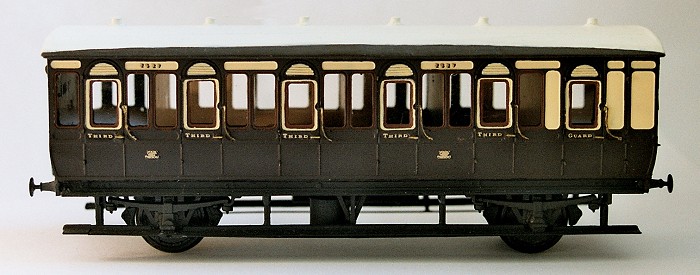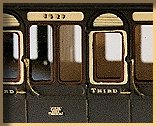|
GWR 4-wheel post-1890 'City' stock
by Russ Elliott

Holden 4-wheel Brake 3rd diagram T59 made from a Shirescenes/Ratio kit.
See how this and an all-3rd Diagram S17 were built
The 4-wheeled 'City' stock used by the GWR in the London area is an attractive subject for modellers. On this page, Russ Elliott describes the 3-arc roof, 8'6" wide types built to Holden designs after 1890.
It would appear that the vast majority of these coaches were built for the London suburban services (Hammersmith & City; Main Line & City; some Middle Circle workings), although I believe some sets saw service in the Birmingham area, but perhaps only after being displaced from London as new stock was built and lines electrified. The completion dates of the lots indicate that there were 23 sets made, each of nominally 9 coaches. It is thought that these vehicles started to depart from London in 1920/21 with the arrival of the 6 sets of Mainline & City Toplight stock, and this departure process continued in 1925 when they were finally displaced by the Collett suburban articulated trains.
Lot 699 was used for strengthening Middle Circle trains, where trains were augmented to 10 or 11 vehicles. (It is difficult to imagine that this augmentation would be done on a 'peak time' only basis, as the coaches within a set were all close-coupled, and putting something in the middle of a set would have been very awkward.)

The characteristic half-circle door vents
All the 8'6" wide stock was designed by Holden, and the doors had semi-circular tops, so that tunnel faces would not be hit in the case of any doors remaining open. Unusually for Great Western coaches, the doors of these suburban sets displayed the class of compartment in large Arabic figures: it is not known exactly when this indication was introduced, but it was present by mid-1905. These figures are to be seen in an enlargement of a picture of an 'Atlantic' class loco 183 when new (in 1905) and before it was named Red Gauntlet in 1906. The figures can also be seen (in the Wild Swan Publications book 'Edwardian Enterprise') on a rake of Metro coaches at Acton in pristine pre-1908 livery. (Jack Slinn's statement in Great Western Way (HMRS) that the figures were introduced c 1913/4 is therefore incorrect.)
Before the introduction of the 3-arc roofed vehicles, the Metro sets were formed by similar sets of 8'-wide, single-arced roof vehicles. Many of these date back to 1880 or earlier. I do not have any lot or diagram information before 1890. These older sets, when displaced by the new 3-arc roof vehicles, may have been displaced to the Birmingham district.
The diagram and lot information provided below was taken from Michael Harris' book (Great Western Coaches 1890-1954, David & Charles): numbers in brackets show the post-1907 renumbering prefix. Some brake vehicles were classified by a different class for the same diagram number: this is thought to be merely a difference in upholstery, the distance between partitions being constant for a particular diagram.
| Lot and Diagram details, 8'6" wide stock |
| Dia |
Date |
Lot |
Type |
Qty |
Numbers (see note) |
| T17 |
04/11/93 |
684 |
Brake third, 28' |
1 |
301 |
| S18 |
04/11/93 |
685 |
Third, 26' |
1 |
302 |
| R5 |
04/11/93 |
686 |
First, 26' |
3 |
(8)028–30 |
| S18 |
04/11/93 |
687 |
Second, 26' |
3 |
(50)41–3 |
| T17 |
04/11/93 |
688 |
Brake second, 28' |
1 |
(50)44 |
| |
|
|
|
|
|
| S18 |
17/02/94 |
699* |
Second, 26' |
12 |
(50)45–53/75–7 |
| |
|
|
|
|
|
| T59 |
30/12/93 |
704 |
Brake third, 31' |
6 |
2621–6 |
| S17 |
30/12/93 |
705 |
Third, 25' |
18 |
2711–28 |
| U6 |
30/12/93 |
706 |
Composite, 28' |
6 |
(7)811–6 |
| R3 |
30/12/93 |
707 |
First, 25' |
6 |
(8)118–23 |
| S17 |
30/12/93 |
708 |
Second, 25' |
10 |
(50)54–63 |
| T59 |
30/12/93 |
709 |
Brake second, 31' |
6 |
(50)66–71 |
| |
|
|
|
|
|
| T59 |
03/02/94 |
711 |
Brake third, 31' |
1 |
2627 |
| S17 |
03/02/94 |
712 |
Third, 25' |
3 |
2729–31 |
| U6 |
03/02/94 |
713 |
Composite, 28' |
1 |
(7)817 |
| R3 |
03/02/94 |
714 |
First, 25' |
1 |
(8)117 |
| S17 |
03/02/94 |
715 |
Second, 25' |
2 |
(50)73/4 |
| T59 |
03/02/94 |
716 |
Brake second, 31' |
1 |
(50)72 |
| |
|
|
|
|
|
| T8 |
03/02/94 |
717 |
Brake third, 26' |
1 |
2628 |
| S18 |
03/02/94 |
718 |
Third, 26' |
3 |
2732–4 |
| R5 |
03/02/94 |
719 |
First, 26' |
2 |
(8)115/6 |
| S18 |
03/02/94 |
720 |
Second, 26' |
2 |
(50)78/9 |
| T8 |
03/02/94 |
721 |
Brake second, 26' |
1 |
(50)80 |
| |
|
|
|
|
|
| T17 |
31/08/95 |
753 |
Brake third, 28' |
1 |
322 |
| S18 |
31/08/95 |
754 |
Third, 26' |
1 |
323 |
| R5 |
31/08/95 |
755 |
First, 26' |
3 |
(80)31–3 |
| S18 |
31/08/95 |
756 |
Second, 26' |
3 |
(50)82–4 |
| T17 |
31/08/95 |
757 |
Brake second, 28' |
1 |
(50)81 |
| |
|
|
|
|
|
| T59 |
22/02/96 |
777 |
Brake third, 31' |
2 |
2693/4 |
| S17 |
22/02/96 |
778 |
Third, 25' |
6 |
2777–82 |
| U6 |
22/02/96 |
779 |
Composite, 28' |
2 |
(7)878/9 |
| R3 |
22/02/96 |
780 |
First, 25' |
2 |
(800)9/10 |
| S17 |
22/02/96 |
781 |
Second, 25' |
4 |
(50)85–8 |
| T59 |
22/02/96 |
782 |
Brake second, 31' |
2 |
(50)89/90 |
| |
|
|
|
|
|
| T59 |
10/10/96 |
805 |
Brake third, 31' |
2 |
2695/6 |
| S17 |
10/10/96 |
806 |
Third, 25' |
6 |
2783–8 |
| U6 |
10/10/96 |
807 |
Composite, 28' |
2 |
(7)882/3 |
| R3 |
10/10/96 |
808 |
First, 25' |
2 |
(80)50/1 |
| S17 |
10/10/96 |
809 |
Second, 25' |
4 |
(50)93–6 |
| T59 |
10/10/96 |
810 |
Brake second, 31' |
2 |
(50)91/2 |
| |
|
|
|
|
|
| T59 |
12/06/97 |
816 |
Brake third, 31' |
2 |
2697/8 |
| S17 |
12/06/97 |
817 |
Third, 25' |
6 |
2789–94 |
| U6 |
12/06/97 |
818 |
Composite, 28' |
2 |
(7)884/5 |
| R3 |
12/06/97 |
819 |
First, 25' |
2 |
(80)52/3 |
| S17 |
12/06/97 |
820 |
Second, 25' |
4 |
(50)97–100 |
| T59 |
12/06/97 |
821 |
Brake second, 31' |
2 |
(50)101/2 |
| |
|
|
|
|
|
| T59 |
15/01/98 |
858 |
Brake third, 31' |
3 |
313/2699–2700 |
| S17 |
15/01/98 |
859 |
Third, 25' |
9 |
303/4/11/2795–800 |
| U6 |
15/01/98 |
860 |
Composite, 28' |
3 |
(7)886–8 |
| R3 |
15/01/98 |
861 |
First, 25' |
3 |
(8)133/8/9 |
| S17 |
15/01/98 |
862 |
Second, 25' |
6 |
(5)106–11 |
| T59 |
15/01/98 |
863 |
Brake second, 31' |
3 |
(5)103–5 |
| |
|
|
|
|
|
| T59 |
26/11/98 |
897 |
Brake third, 31' |
2 |
334/7 |
| S17 |
26/11/98 |
898 |
Third, 25' |
6 |
340/1/3–5/7 |
| U6 |
26/11/98 |
899 |
Composite, 28' |
2 |
(7)891/2 |
| R3 |
26/11/98 |
900 |
First, 25' |
2 |
(8)142/3 |
| S17 |
26/11/98 |
901 |
Second, 25' |
4 |
(5)120–3 |
| T59 |
26/11/98 |
902 |
Brake second, 31' |
2 |
(5)118/9 |
| |
|
|
|
|
|
| T59 |
05/11/98 |
909 ** |
Brake third, 31' |
1 |
2695 |
* Lot 699 was for strengthening Middle Circle trains
** Replacement body for the identically numbered original vehicle condemned after an accident at Paddington in September 1898, but possibly using the repaired underframe from the original vehicle
Note: Numbers in brackets show the post-1907 renumbering prefix.
|
|
Number built
|
| Diagram |
Quantity |
| R3 |
20 |
| R5 |
8 |
| S17 |
98 |
| S18 |
25 |
| T8 |
2 |
| T17 |
2 |
| T59 |
41 * |
| U6 |
20 |
| |
(total 216) |
| * One was a replacement
|
My thanks to John Lewis, for providing corrections and clarifications to the initial version of this page.
Drawings for many of the above diagrams, including standard 8' wide (non-City) short coaching stock, can be found on the Great Western Railway Coaches site.
Russ Elliott
|

